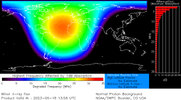SOLAR CYCLE 25 ACTIVITY REPORT JUNE 13_2023
ALL QUIET. Solar activity has been at low levels for the past 24 hours. The largest solar event of the period was a C5 event observed at 06:58 UTC on June 12 from Region 3330 (N18W59)
There are currently 7 numbered sunspot regions on the solar disk: AR3323, AR3326, AR3327, AR3329, AR3330, AR3331, AR3332
AR3321 is gone
Total number of sunspots has decreased to 100 (46 of these are grouped into 7 active regions) NOAA forecasts for the next 24h: 99% chance for C flares, 15% chance for M flares and 1% chance for X flares due to decaying active regions
AR3327 (S15W40 size 40MH) has decayed and now has a stable beta magnetic field.
AR3331 (S15E09 size 150MH) has developed a beta-gamma magnetic field that harbors energy for M-class flares.
● Auroral Activity
The geomagnetic field has been at quiet to unsettled levels for the past 24 hours. Solar wind speed reached a peak of 487 km/s (Normal speed) at 15:59 UTC June 12 Total IMF reached 8 nT at 15:59 UTC the same day.
Aurora Oval Bz: 1.45 nT North

● Current Conditions at 04: 20 UTC on June 13
▪︎ Geospace quiet (kp 2)
▪︎ Solar wind speed record: 459.3 km/sec (Elevated speed)
▪︎ density: 6.74 p/cm³ (low density)
▪︎ Interplanetary Magnetic Field (IMF)
Bt: 6.95 nT (Normal Magnetic Field)
▪︎ Neutron Counts today: -1.0 % (Below average)
▪︎ X-ray Solar Flare: C5:at 23:27 UTC
▪︎ Sunspot number: 100 (SN 116 June 11)
▪︎ Spotless Days 2023 total: 0 days (0%)
-
-SpaceWeatherlive..com
-SpaceWeather.com
ALL QUIET. Solar activity has been at low levels for the past 24 hours. The largest solar event of the period was a C5 event observed at 06:58 UTC on June 12 from Region 3330 (N18W59)
There are currently 7 numbered sunspot regions on the solar disk: AR3323, AR3326, AR3327, AR3329, AR3330, AR3331, AR3332
AR3321 is gone
Total number of sunspots has decreased to 100 (46 of these are grouped into 7 active regions) NOAA forecasts for the next 24h: 99% chance for C flares, 15% chance for M flares and 1% chance for X flares due to decaying active regions
AR3327 (S15W40 size 40MH) has decayed and now has a stable beta magnetic field.
AR3331 (S15E09 size 150MH) has developed a beta-gamma magnetic field that harbors energy for M-class flares.
● Auroral Activity
The geomagnetic field has been at quiet to unsettled levels for the past 24 hours. Solar wind speed reached a peak of 487 km/s (Normal speed) at 15:59 UTC June 12 Total IMF reached 8 nT at 15:59 UTC the same day.
Aurora Oval Bz: 1.45 nT North
● Current Conditions at 04: 20 UTC on June 13
▪︎ Geospace quiet (kp 2)
▪︎ Solar wind speed record: 459.3 km/sec (Elevated speed)
▪︎ density: 6.74 p/cm³ (low density)
▪︎ Interplanetary Magnetic Field (IMF)
Bt: 6.95 nT (Normal Magnetic Field)
▪︎ Neutron Counts today: -1.0 % (Below average)
▪︎ X-ray Solar Flare: C5:at 23:27 UTC
▪︎ Sunspot number: 100 (SN 116 June 11)
▪︎ Spotless Days 2023 total: 0 days (0%)
-
-SpaceWeatherlive..com
-SpaceWeather.com


